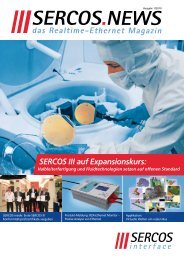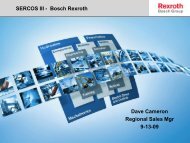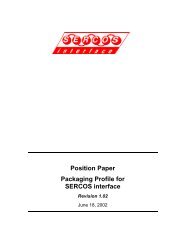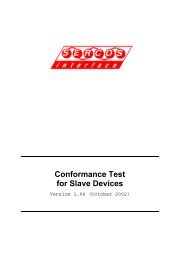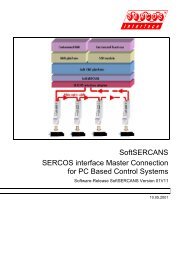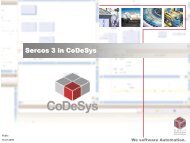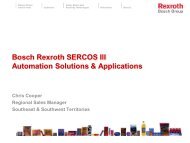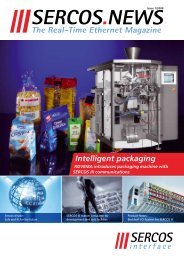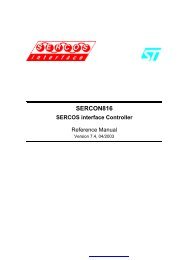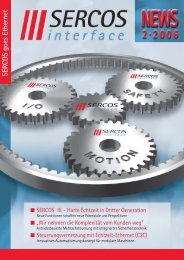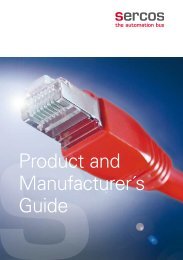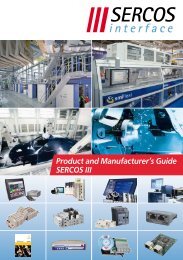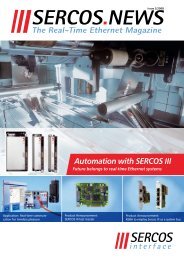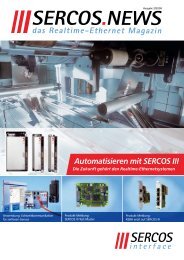Introduction To The SERCOS interface⢠- Sercos N.A.
Introduction To The SERCOS interface⢠- Sercos N.A.
Introduction To The SERCOS interface⢠- Sercos N.A.
You also want an ePaper? Increase the reach of your titles
YUMPU automatically turns print PDFs into web optimized ePapers that Google loves.
<strong>The</strong> format used for an IDN plus a sample IDN are shown in the following illustration.<br />
IDN<br />
Name (abbreviation)<br />
Function/description<br />
Length in bytes<br />
Minimum input value<br />
Maximum input value<br />
Scaling/resolution<br />
Units<br />
S-00047<br />
Position command value<br />
During the position control drive operation mode, the position command values are transferred<br />
from the control unit to the drive according to the time pattern of the control unit cycle.<br />
4 Min. ≥ -2 31<br />
Max. ≤ +2 31 -1<br />
Scaling type: IDN00076<br />
Scaling factor: IDN 00077<br />
Scaling exponent: IDN 00078<br />
Rotational position resolution: IDN 00079<br />
G. Cycle Times<br />
<strong>The</strong> <strong>SERCOS</strong> interface cycle time is specified in a flexible format of 62.5 microseconds,<br />
125, 250, 500, and then multiples of 1 millisecond. <strong>SERCOS</strong> III cycle times begin at<br />
31.25 microseconds. <strong>The</strong> amount & type of data contained in a cycle is also variable.<br />
This flexibility permits a designer to vary cycle time, content and number of drives to<br />
achieve a particular project’s requirements. More data can be sent faster to a smaller<br />
number of drives. Slowing the rate down permits a higher density of drives per ring. For<br />
example, with generations I and II, 4 to 8 axes are common on a ring in machine tool<br />
applications where intense communication is required to control a high-speed tool path.<br />
Up to 40 axes may be controlled on a ring in packaging applications, and up to 100 axes<br />
may be found in web-fed printing applications, where electronic line shafting is utilized<br />
to synchronize a number of print cylinders and auxiliary axes. When necessary, multiple<br />
rings can be employed in an application.<br />
H. Error Correction/Diagnostics<br />
<strong>The</strong> <strong>SERCOS</strong> interface offers extensive diagnostic reporting and produces detailed<br />
reports on fault conditions. This allows vendors to incorporate detailed context-sensitive<br />
troubleshooting procedures in their motion controls. An operator can go to his control<br />
panel and acquire instant diagnosis of every axis motor and drive at every section of the<br />
machine. Failures can be immediately pinpointed by the control system and quickly and<br />
easily be repaired as opposed to hit and miss troubleshooting.<br />
I. Service and IP Channels<br />
Generations I and II <strong>SERCOS</strong> interface include a service channel, which can be used for<br />
the transfer of communication data as well as parameter or diagnostic data in non-realtime.<br />
<strong>To</strong> maintain downward compatibility, <strong>SERCOS</strong> III also has the service channel.<br />
<strong>SERCOS</strong> III also offers an optional IP channel for transfer of real-time and non-real-time<br />
data via standard Ethernet frames. <strong>The</strong> service channel and IP channel are configurable.<br />
<strong>Introduction</strong> to the <strong>SERCOS</strong> interface -- Sept. 2006 -- Page 8



